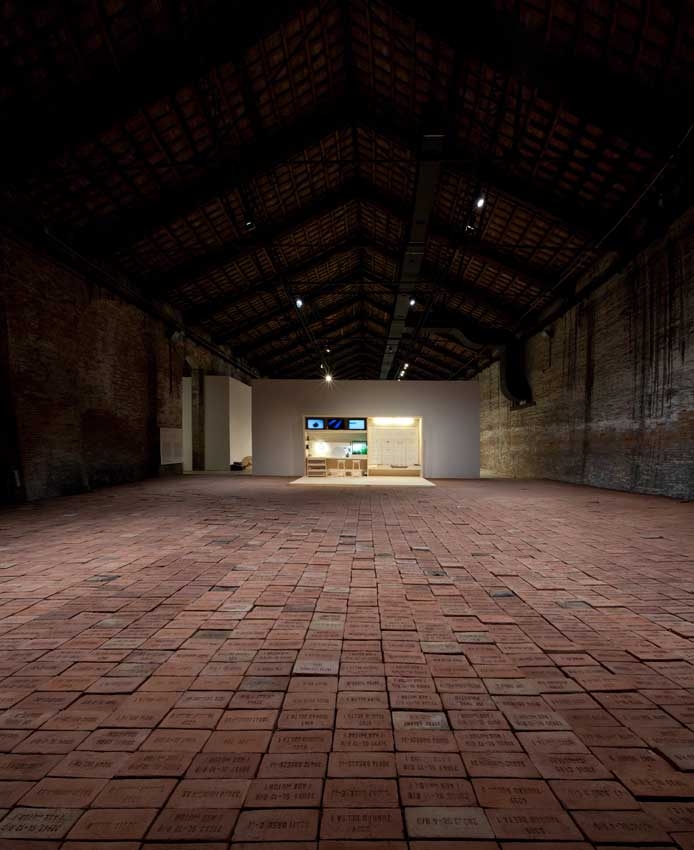Venice seems like an idyllic city, so long as one ignores the facts that its waters are so dirty as to be dangerous to human health, its land practically sinks under the weight of its tourist hordes and its sea views are regularly marred by the presence of huge polluting cruise ships. Venice, like Italy, is full of contradictions, presenting a facade of cultural prestige derived from its past, while facing a future of growing cultural irrelevance on the world stage.
This all said, there is some reason to be cheerful this year as the Venice Biennale’s perennial underachiever – Italy itself – managed an impressive exhibition after years of mediocrity, culminating in the farce that was curator Vittorio Sgarbi’s 2011 pavilion. Sgarbi, former mayor of Sicilian town Salemi and ex-undersecretary to the culture minister under Berlusconi’s Forza Italia party, was appointed curator by Berlusconi’s then culture minister, Sandro Bondi, and proceeded to nominate several hundred university professors from different fields to in turn nominate their favourite living artists. The result – partly because Italian university professors are themselves often out of touch, maintaining their positions through a form of nepotism – was an unmitigated disaster. Sgarbi’s intention – to break open the power clique that presided over the contemporary art scene and invite a wider participation – would have been well founded if it had not been completely self-serving. As part of the rightwing political elite, and a vehement critic of contemporary art, Sgarbi – who is also an art historian and television personality – is naturally not a darling of the broadly left- leaning contemporary art scene. The resulting exhibition was a national embarrassment, a kind of Salon des Refusés selected by a committee of privileged fools.
This year the Italian Pavilion was curated by Bartolomeo Pietromarchi, director, until recently, of Rome’s MACRO – the city’s museum of contemporary art – a contemporary artworld insider with a specialisation in Italian contemporary art. The exhibition, titled Vice Versa, aims to give an overview of recent Italian art via a series of seven dualities, each represented by a different pair of artists, who each present complementary works: Francesco Arena and Fabio Mauri (body/history), Luigi Ghirri and Luca Vitone (view/space), Massimo Bartolini and Francesca Grilli (sound/silence), Giulio Paolini and Marco Tirelli (perspective/surface), Flavio Favelli and Marcello Maloberti (familiar/ strange), Gianfranco Baruchello and Elisabetta Benassi (system/fragment) and Piero Golia and Sislej Xhafa (tragedy/comedy). This ambitious exhibition, comprising 12 new works out of 14, reflects on Giorgio Agamben’s Categorie Italiane, Studi di Poetica (1996; published in English in 1999 as The End of the Poem: Studies in Poetics), in which the Italian philosopher argues that Italy can only be understood in terms ‘of a series of polarised conjugate subjects’. So for example Favelli and Maloberti present La Cupola (2013) and La Voglia Matta (2013), a wooden cupola fashioned after the dome of St Peter’s Basilica and used during religious processions, and a work in which four performers standing atop a piece of Carrara marble continually raise and lower one beach towel each. Both pieces reflect on the familiarity and yet unusual nature of ritual and daily life. Carrara marble is fundamental to Italy’s history, as is the church, with its processions and customs that underpin personal, regional and national identity in a country otherwise difficult to define or understand.
The exhibition includes work by two deceased artists – Fabio Mauri (1926–2009) and Luigi Ghirri (1943–92) – leading to criticisms at the announcement of the artist lineup that the focus was not contemporary or radical enough. Indeed, it is arguable that Pietromarchi didn’t have to do much to outshine his prede- cessor, who is something of a pariah in the contemporary artworld. Pietromarchi’s is a competent, clean pavilion with few shocks. However, this is in itself an accurate reflection of the Italian cultural scene. The exhibition is extravagant yet not flamboyant. Maloberti’s block of marble and Piero Golia’s large cube of concrete mixed with one kilo of gold dust – Untitled (My Gold Is Yours) (2013) – displayed outside the pavilion come across as austere yet elegant. But Pietromarchi’s achievement may reside in having done just enough. Much like Italy’s performance in other fields – football and fashion come to mind – Italy’s contemporary artistic production is characterised by a kind of solemn vivaciousness. Perhaps a welcome antidote to the shocks, irony and highfalutin statements that often characterise biennials.
Following protocol, the new mayor of Rome will now appoint a new culture minister to deal with the appointment of a successor to Pietromarchi at the head of MACRO. The post may well go back to Pietromarchi, which would seem reasonable given his competent stewardship during these hard times. If he does return, he will have much to live up to following Vice Versa.
This article was first published in the September 2013 issue.
